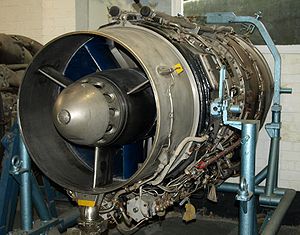- de Havilland Gyron Junior
-
Gyron Junior de Havilland Gyron Junior at the de Havilland Aircraft Heritage Centre Type Turbojet Manufacturer de Havilland Engine Company First run August 1955[1] Major applications Blackburn Buccaneer
Bristol 188Number built 89 Developed from de Havilland Gyron The de Havilland Gyron Junior was a military turbojet engine design of the 1950s developed by the de Havilland Engine Company and later produced by Bristol Siddeley. The Gyron Junior was a scaled-down derivative of the de Havilland Gyron.
Contents
Design and development
Only a little more widely used than the Gyron, it did at least enter serial production for the Blackburn Buccaneer S.1 twin-engined Naval strike aircraft. However it was never a successful engine in service. The Buccaneer S.1 was criticised for being underpowered and the later and more numerous S.2 used the more powerful Rolls-Royce Spey instead.
Twin Gyron Juniors, with afterburners, were also used to power the Bristol 188 Mach 2 supersonic research aircraft. The Rolls-Royce Avon had been considered, but only the Gyron Junior was used in practice. The program was a disappointment, if not a failure, and was terminated early without achieving all of the high-speed high-temperature trials that had been intended. The limitation was the poor fuel consumption of the Gyron Junior and surging from the intakes. This could have been solved with Avons and the successful English Electric Lightning intake design, but the Avro 730 project that the 188 was a research aircraft for had been dropped as a result of US success in that area. Only Mach 1.95 was achieved for a few minutes, endurance at any speed was so restricted by fuel limits that it was impossible to study the long-term "thermal soaking" of a supersonic airframe, as intended. It was big leap for de Havilland from centrifugal- to axial-flow, and was perhaps too far.
Variants
Ref:[1]
- Gyron Junior DGJ.1 (or P.S.43), used on Buccaneer S. Mk.1
- Gyron Junior DGJ.10R (or P.S.50), afterburning version for Bristol 188, thrust 14,000 lb s.t. (62.3 kN)
Applications
- 40 aircraft built[2]
- Only 2 built
- Testing only, 1 production FAW Mk.1 modified[3]
- Intended application, not built
Engines on display
A de Havilland Gyron Junior is on display at the de Havilland Aircraft Heritage Centre, London Colney, Hertfordshire.
Specifications (Gyron Junior DGJ.1)
Data from Gunston[1]
General characteristics
- Type: Single-shaft turbojet
- Length: 102.9 in (2.61 m)
- Diameter: 41.1 in (1.04 m)
- Dry weight:
Components
- Compressor: Seven-stage axial flow
- Combustors: 13 spill-type burners
- Turbine: Two-stage
Performance
- Maximum thrust: 7,100 lb s. t. (31.6 kN)
- Overall pressure ratio: 6.4:1
- Turbine inlet temperature: 1,200 oC
- Power-to-weight ratio:
See also
- Related development
- Comparable engines
- Related lists
References
- ^ a b c Gunston, Bill (1989). World Encyclopaedia of Aero Engines. Wellingborough: Patrick Stephens. pp. 52. ISBN 1-85260-163-9.
- ^ Jackson, A.J. (1968). Blackburn Aircraft since 1909. London: Putnam Publishing. pp. 494. ISBN 0 370 00053 6.
- ^ James, Derek N. (1971). Gloster Aircraft since 1917. London: Putnam Publishing. pp. 322, 326, 370. ISBN 0 370 00084 6.
External links
de Havilland aero engines Piston engines Ghost · Gipsy · Gipsy Junior · Gipsy Minor · Gipsy Major · Gipsy Six · Gipsy Queen · Gipsy Twelve · Gipsy King · Iris
Turbojet Turboprop/turboshaft Rocket Designers Bristol / Bristol Siddeley aero engines Bristol Aeroplane Company
Piston engines (1920-1956)Bristol Siddeley gas turbine
and rocket engines (1959-1966)Designers Lists relating to aviation General Aircraft (manufacturers) · Aircraft engines (manufacturers) · Airlines (defunct) · Airports · Civil authorities · Museums · Registration prefixes · Rotorcraft (manufacturers) · TimelineMilitary Accidents/incidents Records Categories:- Turbojet engines 1950-1959
- De Havilland aircraft engines
- Bristol aircraft engines
Wikimedia Foundation. 2010.

